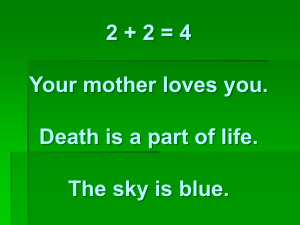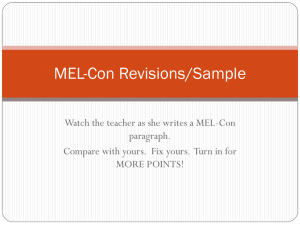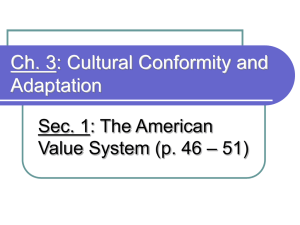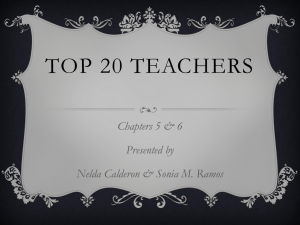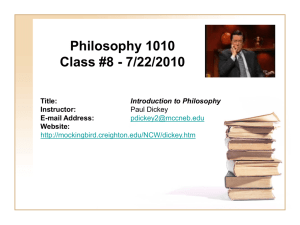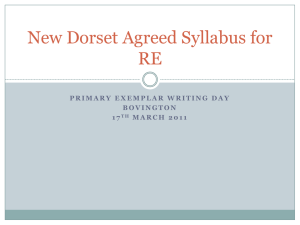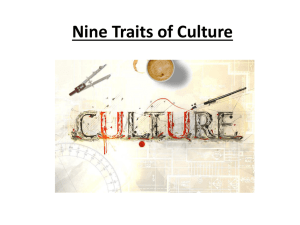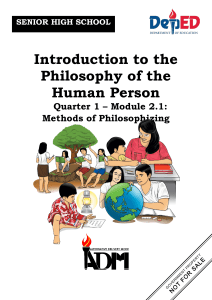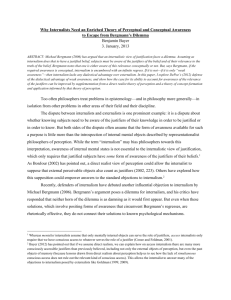File
advertisement
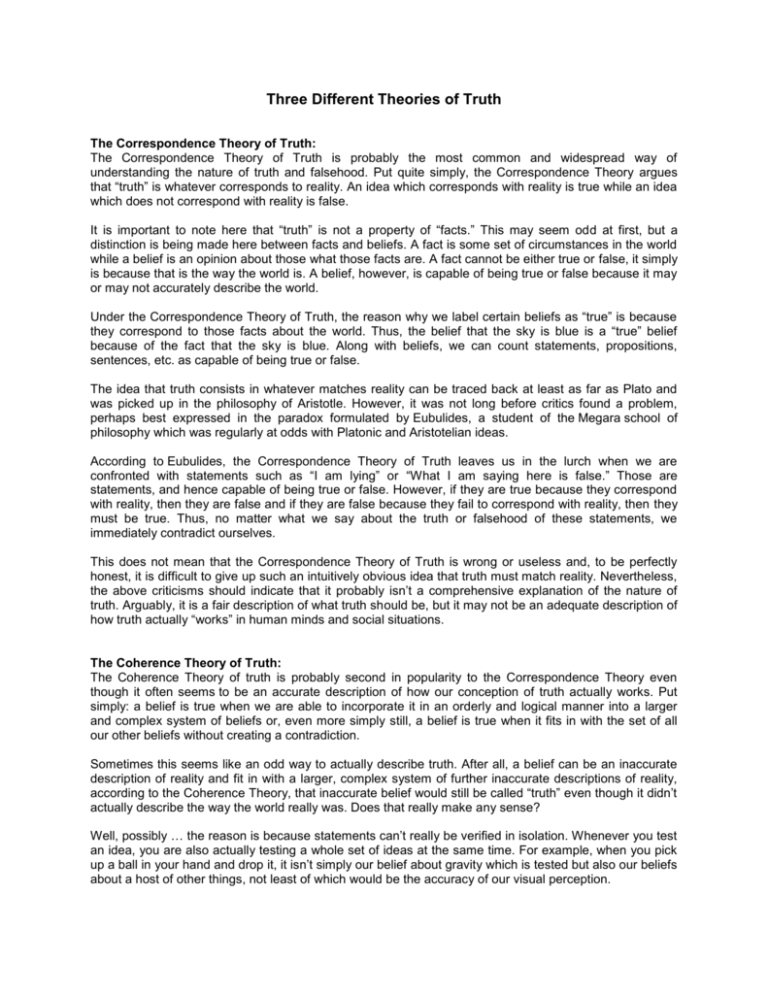
Three Different Theories of Truth The Correspondence Theory of Truth: The Correspondence Theory of Truth is probably the most common and widespread way of understanding the nature of truth and falsehood. Put quite simply, the Correspondence Theory argues that “truth” is whatever corresponds to reality. An idea which corresponds with reality is true while an idea which does not correspond with reality is false. It is important to note here that “truth” is not a property of “facts.” This may seem odd at first, but a distinction is being made here between facts and beliefs. A fact is some set of circumstances in the world while a belief is an opinion about those what those facts are. A fact cannot be either true or false, it simply is because that is the way the world is. A belief, however, is capable of being true or false because it may or may not accurately describe the world. Under the Correspondence Theory of Truth, the reason why we label certain beliefs as “true” is because they correspond to those facts about the world. Thus, the belief that the sky is blue is a “true” belief because of the fact that the sky is blue. Along with beliefs, we can count statements, propositions, sentences, etc. as capable of being true or false. The idea that truth consists in whatever matches reality can be traced back at least as far as Plato and was picked up in the philosophy of Aristotle. However, it was not long before critics found a problem, perhaps best expressed in the paradox formulated by Eubulides, a student of the Megara school of philosophy which was regularly at odds with Platonic and Aristotelian ideas. According to Eubulides, the Correspondence Theory of Truth leaves us in the lurch when we are confronted with statements such as “I am lying” or “What I am saying here is false.” Those are statements, and hence capable of being true or false. However, if they are true because they correspond with reality, then they are false and if they are false because they fail to correspond with reality, then they must be true. Thus, no matter what we say about the truth or falsehood of these statements, we immediately contradict ourselves. This does not mean that the Correspondence Theory of Truth is wrong or useless and, to be perfectly honest, it is difficult to give up such an intuitively obvious idea that truth must match reality. Nevertheless, the above criticisms should indicate that it probably isn’t a comprehensive explanation of the nature of truth. Arguably, it is a fair description of what truth should be, but it may not be an adequate description of how truth actually “works” in human minds and social situations. The Coherence Theory of Truth: The Coherence Theory of truth is probably second in popularity to the Correspondence Theory even though it often seems to be an accurate description of how our conception of truth actually works. Put simply: a belief is true when we are able to incorporate it in an orderly and logical manner into a larger and complex system of beliefs or, even more simply still, a belief is true when it fits in with the set of all our other beliefs without creating a contradiction. Sometimes this seems like an odd way to actually describe truth. After all, a belief can be an inaccurate description of reality and fit in with a larger, complex system of further inaccurate descriptions of reality, according to the Coherence Theory, that inaccurate belief would still be called “truth” even though it didn’t actually describe the way the world really was. Does that really make any sense? Well, possibly … the reason is because statements can’t really be verified in isolation. Whenever you test an idea, you are also actually testing a whole set of ideas at the same time. For example, when you pick up a ball in your hand and drop it, it isn’t simply our belief about gravity which is tested but also our beliefs about a host of other things, not least of which would be the accuracy of our visual perception. So, if statements are only tested as part of larger groups, then one might conclude that a statement can be classified as “true” not so much because it can be verified against reality but rather because it could be integrated into a group of complex ideas, the whole set of which could then be tested against reality. In this case Coherence Theory isn’t that far from the Correspondence Theory and the reason is that while individual statements may be judged as true or false based upon their ability to cohere with a larger system, it is assumed that that system is one which accurately corresponds to reality. Because of this, the Coherence Theory does manage to capture something important about the way we actually conceive of truth in our daily lives. It isn’t that unusual to dismiss something as false precisely because it fails to cohere with a system of ideas which we are confident are true. Granted, maybe the system we assume to be true is quite a way off the mark, but so long as it continues to be successful and is capable of slight adjustments in the light of new data, our confidence is reasonable. The Pragmatic Theory of Truth: The Pragmatic Theory of truth determines whether or not a belief is true or not based on whether it has a useful (pragmatic) application in the world. If it does not, then it is not true. As with Coherence Theory, truth in this sense is nothing to do with the way the world ‘really is’ but is just a function of whether an idea can be used as a model to make useful predictions about what is going to happen in the world. As a result pragmatic truths can only be learnt through interaction with the world: we don’t discover truth by sitting alone in a room and thinking about it. There are, of course, a number of obvious objections that can be raised against the Pragmatic Theory of Truth. For one thing, the notion of “what works” is very ambiguous. What happens when a belief works in one sense, but fails in another? For example, a belief that one will succeed may give a person the psychological strength needed to accomplish a great deal but in the end, they may fail in their ultimate goal. Was their belief “true”? Furthermore, when a belief “works” in this sense, why call it “true”? Why not call it something like “useful”? A useful belief is not necessarily the same as a true belief and, what’s worse, is that people don’t typically use the word “true” in normal conversation to mean useful. For example, for the average person, the statement “It is useful to believe that my spouse is faithful” does not at all mean the same as “It is true that my spouse is faithful.” Granted, it may be the case that true beliefs are also usually the ones that are useful, but not always. As Nietzsche argued, sometimes untruth may be more useful than truth. Now, pragmatism may be a handy means for distinguishing truth from untruth. After all, that which is true should produce predictable consequences for us in our lives. In order to determine what is real and what is unreal, it would not be unreasonable to focus primarily upon that which works. This, however, is not quite the same as the Pragmatic Theory of Truth. Adapted from articles by Austin Cline http://atheism.about.com/b/2007/05/29/epistemology-correspondence-theory-of-truth.htm
